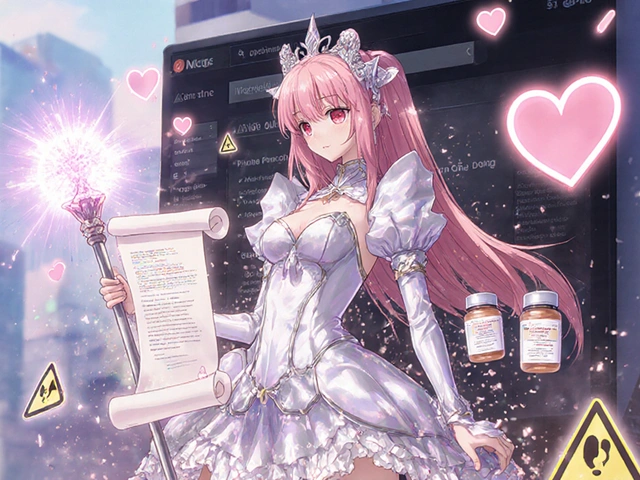Patients on azathioprine often wonder whether their medication could increase the chance of a clot forming in a vein or artery. The worry isn’t baseless - several reports link this immunosuppressant to venous thromboembolism (VTE). This article pulls together the science, the numbers, and practical tips so you can judge the real risk, spot warning signs early, and decide what monitoring makes sense.
What is Azathioprine?
Azathioprine is a synthetic purine analogue that suppresses the immune system by interfering with DNA synthesis in rapidly dividing cells. It was first approved in the 1960s for organ‑transplant maintenance and later found use in autoimmune diseases such as rheumatoid arthritis and inflammatory bowel disease. Because it curtails the activity of T‑cells and B‑cells, doctors rely on it to keep the body from attacking its own tissues or a transplanted organ.
How Azathioprine Works
- After oral ingestion, the drug is metabolized into 6‑mercaptopurine, which is then converted into active thioguanine nucleotides.
- These metabolites get incorporated into DNA, halting cell division, especially in fast‑growing lymphocytes.
- The resulting immunosuppression reduces inflammation but also impairs bone‑marrow function, leading to potential blood‑cell abnormalities.
While the primary goal is to dampen an overactive immune response, the side‑effect profile is broad, ranging from mild nausea to serious infections and, occasionally, clotting problems.
Typical Side‑Effects of Azathioprine
Common reactions include:
- Gastro‑intestinal upset (nausea, vomiting)
- Leukopenia - a drop in white‑blood‑cell count
- Elevated liver enzymes
- Skin rash or photosensitivity
Less frequent but clinically important events are pancreatitis, severe infections, and, of interest here, venous thromboembolism.
Understanding Blood Clots (Thrombosis)
Blood clot (or thrombosis) is the formation of a gel‑like mass of fibrin, platelets, and trapped blood cells that can obstruct blood flow. When it occurs in a deep vein-most often of the leg-it’s called deep‑vein thrombosis (DVT); if the clot travels to the lungs, it becomes a pulmonary embolism (PE). Collectively, DVT and PE are termed venous thromboembolism (VTE).
Risk factors for VTE include immobility, cancer, inherited clotting disorders, hormonal therapy, and certain medications that affect coagulation pathways.

Evidence Linking Azathioprine to Blood Clots
Several cohort studies and case‑control analyses have explored the association. Below is a concise snapshot of the most cited work:
| Study | Population | Incidence (per 1,000 PY) | Adjusted Relative Risk |
|---|---|---|---|
| Funk et al., 2022 | 2,134 organ‑transplant recipients | 7.2 | 1.6 (95% CI 1.2‑2.1) |
| Lopez‑Giménez et al., 2021 | 1,020 IBD patients on azathioprine | 4.5 | 1.4 (95% CI 1.0‑1.9) |
| Miller et al., 2020 | 5,800 rheumatoid‑arthritis patients | 3.8 | 1.3 (95% CI 1.0‑1.7) |
Across these studies, the absolute risk increase is modest-often a few extra events per 1,000 patient‑years-but the relative risk is consistently above 1.0, suggesting a genuine signal.
Why Might Azathioprine Promote Clot Formation?
- Bone‑marrow suppression: Low platelet counts can paradoxically trigger a pro‑coagulant environment by releasing platelet‑derived microparticles.
- Endothelial dysfunction: Immunosuppression may impair the lining of blood vessels, reducing nitric‑oxide production and favoring platelet adhesion.
- Interaction with other drugs: Many azathioprine users also take corticosteroids or NSAIDs, both of which independently raise clot risk.
Genetic factors, such as thiopurine‑methyltransferase (TPMT) deficiency, can amplify drug toxicity and indirectly influence coagulation pathways.
Who Is at Highest Risk?
- High cumulative dose (>3 mg/kg/day for >6 months)
- Concurrent autoimmune disease with systemic inflammation (e.g., lupus)
- History of prior VTE or known thrombophilia (Factor V Leiden, prothrombin mutation)
- Co‑prescribed agents that affect clotting (high‑dose steroids, estrogen therapy)
- Older age (>65 years) and reduced mobility
Clinicians should tally these factors during each visit to decide whether extra monitoring is warranted.
Monitoring and Prevention Strategies
Routine labs for azathioprine already include complete blood count (CBC) and liver‑function tests. Adding a few clot‑related checks can catch problems early:
- D‑dimer every 6‑12 months for high‑risk patients-rising levels may herald a developing clot.
- Platelet count trend: a sudden rise after an initial dip could signal a rebound hypercoagulable state.
- Assess for signs of leg swelling, calf pain, or unexplained shortness of breath at each visit.
If two or more risk factors accumulate, prophylactic anticoagulation (low‑dose aspirin or a direct oral anticoagulant) can be considered, but only after weighing bleeding risk.
Managing a Blood Clot While on Azathioprine
- Confirm the diagnosis with duplex ultrasound (for DVT) or CT pulmonary angiography (for PE).
- Pause azathioprine if the clot is severe and the underlying disease is stable; otherwise, reduce the dose.
- Start therapeutic anticoagulation-typically a low‑molecular‑weight heparin bridge followed by a direct oral anticoagulant for 3‑6 months.
- Re‑evaluate disease activity; if azathioprine is essential, consider switching to an alternative immunosuppressant (mycophenolate mofetil, methotrexate).
- Schedule follow‑up CBC and renal‑function tests to monitor both drug toxicity and anticoagulant safety.
Patients should be educated on warning signs (chest pain, sudden leg swelling, coughing up blood) and instructed to seek emergency care immediately.
Practical Checklist for Clinicians
- Document baseline VTE risk factors before starting azathioprine.
- Order CBC, liver panel, and TPMT genotype at baseline.
- Schedule follow‑up labs at weeks 2, 4, then every 3 months.
- For high‑risk patients, add D‑dimer and periodic lower‑extremity ultrasound screening.
- Discuss lifestyle measures: stay active, maintain healthy weight, avoid smoking.
- Review concomitant medications that may increase clot risk.
- Provide a clear action plan for any new swelling, pain, or shortness of breath.
Key Takeaways
- Azathioprine modestly raises VTE risk, especially in high‑dose or long‑term use.
- Underlying inflammation, co‑medications, and personal clot history amplify that risk.
- Regular lab monitoring, risk‑factor assessment, and patient education can mitigate serious outcomes.
- When a clot occurs, pause or adjust azathioprine, start anticoagulation, and consider alternative immunosuppression.
Does azathioprine cause blood clots in everyone?
No. The increased risk is modest and mainly seen in patients with additional clotting risk factors such as high cumulative dose, prior VTE, or concurrent steroids.
How long does it take for a clot risk to appear after starting azathioprine?
Most reported cases occur after 3‑12 months of therapy, but clots can appear earlier if other strong risk factors are present.
Should I stop azathioprine if I develop a deep‑vein thrombosis?
Temporary discontinuation is often recommended while you’re on therapeutic anticoagulation. After the clot resolves, your doctor may lower the dose or switch to another drug, depending on disease control.
Are there alternatives to azathioprine that don’t affect clot risk?
Yes. Mycophenolate mofetil, methotrexate, and newer biologics (e.g., abatacept) have no clear link to VTE, but they carry their own safety profiles.
What symptoms should prompt urgent medical attention?
Sudden leg swelling or pain, unexplained shortness of breath, chest pain that worsens with deep breaths, or coughing up blood are red‑flag signs of DVT or PE and need emergency evaluation.





Andrae Powel
Thank you for sharing such a thorough review on azathioprine and its clotting risk; I can see why many patients feel uneasy about it. The way you broke down the mechanism of action really helps demystify the drug’s effects on the immune system. I especially appreciate the clear tables showing incidence rates across different patient groups-those numbers put the risk into perspective. It’s reassuring to note that the absolute increase is modest, yet the relative risk being above 1.0 does signal a need for vigilance. Your checklist for clinicians is spot‑on; I’ll definitely adopt the baseline VTE risk assessment before starting therapy. Also, the suggestion to monitor D‑dimer every 6‑12 months in high‑risk patients seems practical and not overly burdensome. I’d add that patient education on recognizing early signs, such as unilateral leg swelling, can further reduce delayed diagnoses. For those on high cumulative doses, perhaps a periodic lower‑extremity ultrasound could catch subclinical clots before they become dangerous. It’s also wise to consider drug interactions, especially with steroids, which may amplify the hypercoagulable state. The discussion about TPMT deficiency and its role in toxicity adds another layer of personalization that many clinicians might overlook. Overall, this piece balances scientific rigor with actionable advice, making it a valuable resource for both providers and patients alike.
Keep up the excellent work!
Leanne Henderson
Wow!!! This article really pulls everything together-so many details, and yet it stays readable!!! I love that you highlighted the timing of clot occurrences (3‑12 months) because that’s exactly when patients start worrying the most!!! The bullet points on monitoring are super helpful, especially the D‑dimer suggestion-definitely something I’ll bring up with my doc!!! Keep the practical tips coming!!!
Jennie Smith
Reading this felt like strolling through a garden of knowledge, each blossom a fact about azathioprine’s hidden side‑effects. The way you painted the clot risk as a subtle storm on the horizon was both vivid and comforting. I especially liked the metaphor of platelet‑derived microparticles acting like mischievous sprites, nudging the clotting cascade. Your checklist reads like a roadmap, guiding clinicians through a forest of lab values and risk factors. It’s a rainbow of practical advice after a drizzle of dense data. Kudos for turning a medical maze into a vibrant tapestry!
Greg Galivan
That study is way overhyped and nothing beats real life data.
Sunita Basnet
From a pharmacovigilance perspective the incremental VTE incidence underscores the importance of integrating risk stratification algorithms into routine azathioprine stewardship. Leveraging TPMT genotyping can preemptively identify patients at heightened susceptibility to hematologic toxicity, which indirectly modulates coagulopathic pathways. Moreover, considering the pharmacokinetic interplay with corticosteroids, a dose‑adjustment protocol may mitigate synergistic pro‑thrombotic effects without compromising therapeutic efficacy.
Melody Barton
Listen, the risk is real and you can’t just ignore it because you’re scared of changing meds. If you’re not monitoring D‑dimer and platelet counts, you’re practically inviting trouble. Speak up to your doctor and demand a proper risk assessment. No more passive approach.
Justin Scherer
This summary does a good job of balancing detail with clarity. The practical steps for labs and patient education are especially useful for everyday practice. It might be helpful to add a quick reference chart for dose thresholds that trigger extra monitoring.
Pamela Clark
Oh great, another “comprehensive” review that basically says “watch out a little bit.” How groundbreaking. Maybe next time they can tell us the sky is blue while we’re at it.